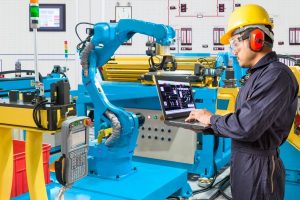Robots that offer point-to-point delivery are poised to become hot sellers for e-commerce companies and businesses that are looking to improve inventory control, order processing methods and labor efficiency to speed up operations. E-Commerce in the 21st century will be driven in large part, by robotic workers.
 “Point-to-point mobile robots are popular now because they can replace humans with simple, easy to operate devices that do the same job for less cost, hence a fast ROI [return on investment],” Frank Tobe, co-founder of ROBO Global which has developed a tracking index for the robotics industry, wrote in his blog The Robot Report.
“Point-to-point mobile robots are popular now because they can replace humans with simple, easy to operate devices that do the same job for less cost, hence a fast ROI [return on investment],” Frank Tobe, co-founder of ROBO Global which has developed a tracking index for the robotics industry, wrote in his blog The Robot Report.
With the influx of robotic workers, it would seem that they would leave a wake of unemployed human workers. However, there’s evidence that isn’t the case. When online retailer, Boxed began using robots, employees found their jobs less physically demanding. Instead of walking thousands of steps daily, employees could stand at stations as conveyor belts brought the goods to them. Instead of cutting jobs, they became more efficient, and added a third shift to keep up with the growing demand.
When thinking about robots, we think about machines rolling around fetching items, while humans do what they do best, manipulate the items. The paradigm continues to exist as a human remains in charge of the crucial, and very complex final steps of filling boxes.
Even with the rise of robotic workers, the number of e-commerce and warehousing jobs has increased by 400,000 in the past decade. Amazon accounts for much of the additional employment. Yet it’s also at the vanguard of automation. Since 2014, Amazon has deployed 100,000 robots in 25 warehouses worldwide. At the same time, it’s nearly tripled its hourly workforce, from roughly 45,000 to nearly 125,000. Its use of robotics has shaved the operating costs for a warehouse by about 20 percent, according to a report by Deutsche Bank. Such savings, in turn, have lowered the cost for Amazon to open new facilities — and hire more workers.
Automation and robotic workers will only get more sophisticated in the future. According to Mark Wulfraat, president of MWVPL, a consulting firm, “What’s going to happen next is robotic arms, combined with vision technology and suction technology”.
Advances in artificial intelligence, big data and sensor technology, as well as the falling cost of these systems, is what is making it possible for leading retailers to invest millions of dollars to meet new retail needs.
Universe Optics is your best choice when it’s time to design a precision lens to fit your e-commerce automation needs. Our team of dedicated engineers along with our manufacturing team will deliver ensure your lens offers the clearest image possible.
While automated technology has been around for a while, the intelligence of these machines and how they collaborate with each other and humans is what is evolving.
As e-commerce around the globe flourishes and customers increasingly expect quicker delivery times, online retailers are looking for greater efficiencies in the supply chain to meet these.